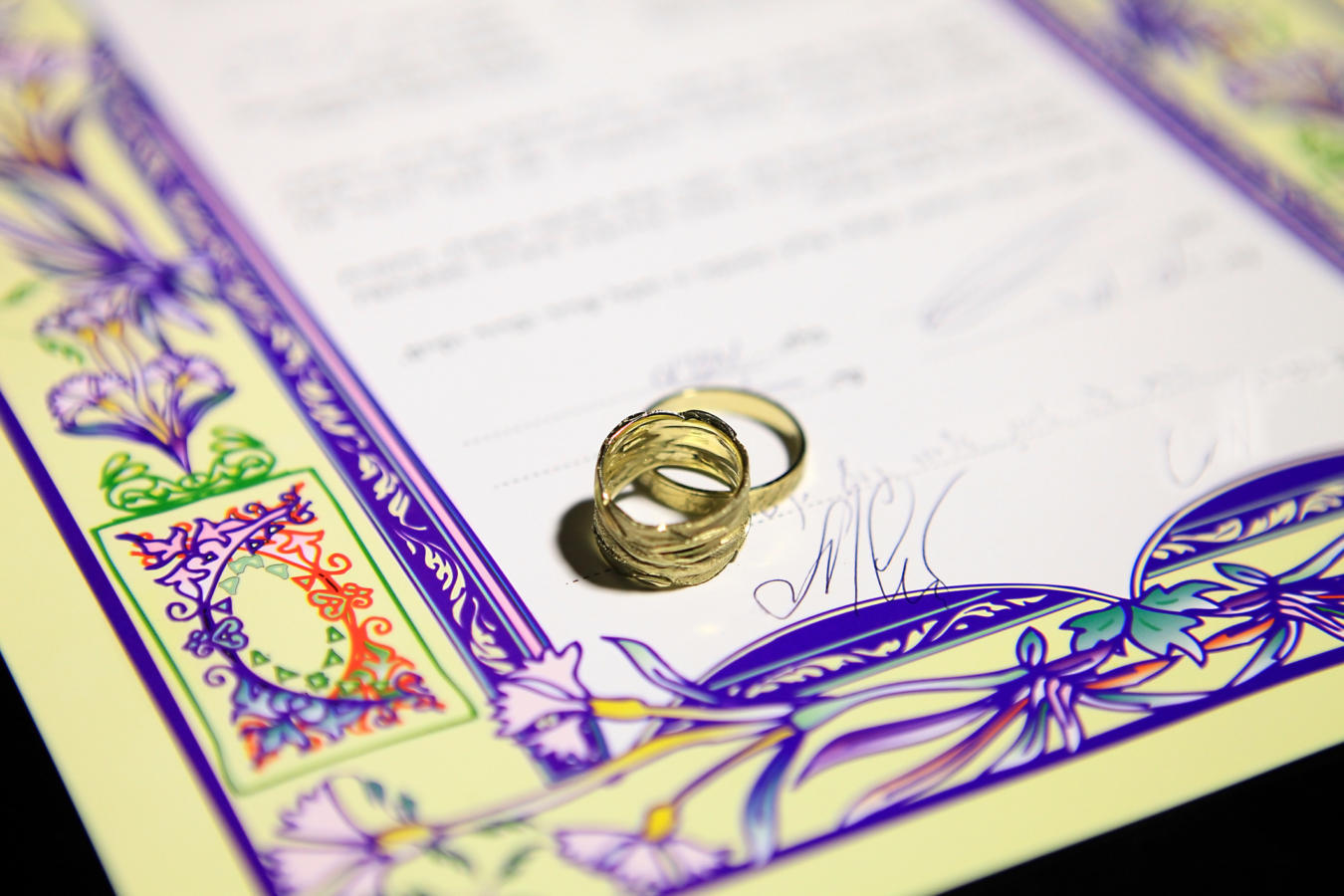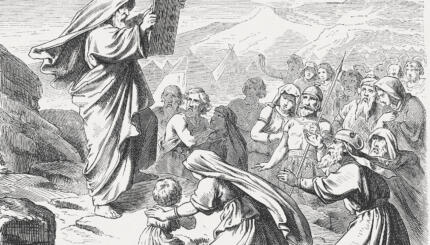In many Sephardic congregations, prior to the Torah reading on the first day of Shavuot a ketubah le-Shavuot (marriage certificate for Shavuot) is read as a symbolic betrothal of God and His people Israel. There are various versions of such piyyutim (religious poems), nearly all similar in terminology to the traditional t’naim [literally “conditions”] the premarital document specifying the conditions agreed upon between the two parties) or the ketubah (certificate the bridegroom presents to the bride at the wedding ceremony).
These are hymns based on the verses, “I will betroth thee unto Me for ever; yea, I will betroth thee unto Me in righteousness, and in justice, and in lovingkindness, and in compassion. And I will betroth thee unto Me in faithfulness, and thou shalt know the Lord” (Hosea 2:21-22) and “I will make a new covenant with the house of Israel” (Jeremiah 31:31).
Some texts describe the marriage as being solemnized symbolically between the Torah–the bride–and the people of Israel, the bridegroom. In these versions, God as the bride’s father gives as dowry the 613 commandments, the Bible, Talmud, and other sacred writings. Moses presents as dowry to his son–the people of Israel–the prayer shawl and phylacteries, the Sabbath and festivals. The contracts are witnessed by God and His servant Moses.
In other versions, the “Prince of princes and the Ruler of rulers” presents the Torah to the bride as dowry, and in His love He gives her the Oral Law as an added portion. The bride responds affectionately, “We shall do and we shall hearken.” The contract is dated the sixth day of the month Sivan in the year 2448 from the creation, which is traditionally the day on which the Torah was given. The Mishnah comments that the wedding day of King Solomon (Song of Songs 3.11) refers to the day of the giving of the Torah. The heavens and the earth witness the marriage certificate.
With your help, My Jewish Learning can provide endless opportunities for learning, connection and discovery.
The most widely used text of a ketubah le-Shavuot is that of the prolific Safed mystic and poet Israel Najara (c.1550-c.1625). Many of his piyyutim are found in the liturgy of Oriental Jews. A partial translation of his hymn, included in the Sephardic prayer book for Shavuot, follows:
Friday, the sixth of Sivan, the day appointed by the Lord for the revelation of the Torah to His beloved people… The Invisible One came forth from Sinai, shone from Seir and appeared from Mount Paran unto all the kings of the earth, in the year 2448 since the creation of the world, the era by which we are accustomed to reckon in this land whose foundations were upheld by God, as it is written, ‘For He hath founded it upon the seas and established it upon the floods’ (Psalms 24.2).
The Bridegroom [God], Ruler of rulers, Prince of princes, Distinguished among the select, Whose mouth is pleasing and all of Whom is delightful, said unto the pious, lovely and virtuous maiden [the people of Israel] who won His favor above all women, who is beautiful as the moon, radiant as the sun, awesome as bannered hosts: Many days wilt thou be Mine and I will be thy Redeemer.
Behold, I have sent thee golden precepts through the lawgiver Jekuthiel [Moses]. Be thou My mate according to the law of Moses and Israel, and I will honor, support, and maintain thee and be thy shelter and refuge in everlasting mercy. And I will set aside for thee, in lieu of thy virginal faithfulness, the life-giving Torah by which thou and thy children will live in health and tranquility.
This bride [Israel] consented and became His spouse. Thus an eternal covenant, binding them forever, was established between them. The Bridegroom then agreed to add to the above all future expositions of Scripture, including Sifra, Sifre, Aggadah, and Tosefta. He established the primacy of the 248 positive commandments that are incumbent upon all… and added to them the 365 negative commandments. The dowry that this bride brought from the house of her father consists of an understanding heart that understands, ears that hearken, and eyes that see.
Thus the sum total of the contract and the dowry, with the addition of the positive and negative commandments, amounts to the following: ‘Revere God and observe His commandments; this applies to all mankind’ (Ecclesiastes 12:13). The Bridegroom, desiring to confer privileges upon His people Israel and to transmit these valuable assets to them, took upon Himself the responsibility of this marriage contract, to be paid from the best portions of His property…
All these conditions are valid and established forever and ever. The Bridegroom has given His oath to carry them out in favor of His people and to enable those that love Him to inherit substance. Thus the Lord has given His oath. The Bridegroom has followed the legal formality of symbolic delivery of this document, which is bigger than the earth and broader than the seas. Everything, then, is firm, clear, and established…
I invoke heaven and earth as reliable witnesses.
May the Bridegroom rejoice with the bride whom He has taken as His lot and may the bride rejoice with the Husband of her youth while uttering words of praise.
Reprinted with permission from The Shavuot Anthology published by the Jewish Publication Society. The ketubah is translated by Solomon Feffer.
ketubah
Pronounced: kuh-TOO-buh, Origin: Hebrew, the Jewish wedding contract.
Mishnah
Pronounced: MISH-nuh, Origin: Hebrew, code of Jewish law compiled in the first centuries of the Common Era. Together with the Gemara, it makes up the Talmud.
Sephardic
Pronounced: seh-FAR-dik, Origin: Hebrew, describing Jews descending from the Jews of Spain.
Shavuot
Pronounced: shah-voo-OTE (oo as in boot), also shah-VOO-us, Origin: Hebrew, the holiday celebrating the giving of the Torah at Mount Sinai, falls in the Hebrew month Sivan, which usually coincides with May or June.
Sivan
Pronounced: see-VAHN, Origin: Hebrew, Jewish month, usually coinciding with May-June.
Torah
Pronunced: TORE-uh, Origin: Hebrew, the Five Books of Moses.



